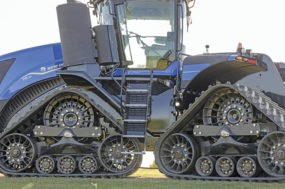We were on the way to visit family in southern Idaho and had topped the infamous Cabbage mountain grade just east of Pendleton, Oregon, and not yet to the Blue Mountains summit.
Simultaneously to the check engine light coming on, the pickup shuddered, lost power and began blowing a cloud of black smoke. I pulled off the road and shut it off. After a few seconds, I restarted it, and it idled fine. I gingerly pulled back on the freeway and got another couple of miles up the road when it started snorting and bucking again. I idled it into a wide spot and shut it down again.
I retrieved my Smarty Jr. code reader and plugged it in. When it fired up, I went to DTC (diagnostic trouble codes), and it gave me a laundry list. Let me first give you the history on this truck. About a hundred thousand miles before, I’d had an under-warranty incident where the wiring harness to the fuel injectors had an issue. The harness and two injectors were replaced. I was expecting a recurrence of this issue – until I read through the laundry list of complaints from the scanner.
Listed were: three injectors failing to provide adequate fuel, the wiring harness to the injectors having a hissy fit, intake air pressure being low, exhaust temperature being low and a couple more I can’t remember.
My mind works to consider the worst-case scenario first, and I wondered if I’d be able to limp another 30 miles to La Grande, Oregon, to a Cummins or Dodge dealer. Then I noted that this had been of sudden onset. Most electrical issues usually start as gremlins and hiccups unless an electrical cable has gotten wrapped around a drive shaft or something.
I considered the mechanical things – the rough running, loss of power and black smoke. Then I added the overdue fuel filter change to the formula. “What would the computer do if there was not enough fuel pressure?” I asked. Since low fuel pressure was not on the DTC’s laundry list, I concluded the computer was programmed to always assume that fuel pressure was adequate.
These injectors work with a standing high pressure of fuel, and then the injectors, via piezo technology, open and close three times per injection cycle to give a starter burst that quells the traditional diesel “knock,” followed by a main burst to provide adequate power to the engine and then a late “squirt” to keep the catalytic converter hot enough to function.
The high pressure causes the diesel fuel to atomize on injection, to burn quickly and cleanly. A low-fuel-pressure situation would give a sloppy drizzle instead of an atomized mist, which would create a difficult-to-ignite situation, causing black smoke.
This would cause a lack of power, which would cause the computer to order the injectors to open wider, and this would add to the black smoke. Since the injectors were not following the directive from the computer to make power, the computer would assume the injectors did not get the signal for more fuel and throw the code on the wiring harness.
Since many years of trucking experience with pre-computerized engines left me with experience of the symptoms of a dirty fuel filter, I ignored the DTC list and retrieved the new fuel filter from behind the back seat of my mega-cab and installed it.
I cleared the trouble codes, which turned off the check-engine light, and started my baby. As soon as the air cleared from changing the fuel filter, it ran smooth. Back on the freeway, it ran like it was brand spanking new. I stopped in La Grande and put the scanner on again. No codes. I was kicking myself for not having changed the fuel filter before. My wife, however, thought I was a miracle worker for fixing it roadside.
I made a mental note to consider, in the future, what part of the mechanicals of a rig the computer will by default consider to be OK – especially those things that would throw a code by symptom and not necessarily by cause.
This mental note was confirmed a couple of years later when my wife’s Grand Marquis started having issues. After chasing symptoms and changing parts the code scanner said were kaput (and not curing the problem), I had to remind myself that taking up drinking whiskey would not help.
I finally asked a friend who twists wrenches for a living every day. After suggesting everything I’d already changed, he said that occasionally a plugged catalytic converter would make the car have the driveability issues I was having. Three days and $135 later (including shipping) that Mercury was running like a hot-rod Lincoln.
Yes, computers do wonderful things. But understanding the basic mechanics and inputs the computers have (or lack thereof) has much to do with a successful repair. ![]()










